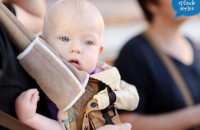Parent Savers
Your Baby’s Vision
[00:00:00]
Please be advised, this transcription was performed from a company independent of New Mommy Media, LLC. As such, translation was required which may alter the accuracy of the transcription.
[Theme Music]
Dr. LISA WEISS: Cooing, sitting up and crawling are signs that a baby is growing. A baby vision has stages of development but this process really has visible signs. A hundred thousand (100,000) infants a year are at risk for vision disorder and one in ten young children have an eye problem that could have been diagnosed sooner. How can you get vision help for free? I am Dr. Lisa Weiss Optometrist with infancy and this is Parents Savers episode 32.
[Theme Music/Intro]
KC WILT: Welcome to Parents Savers, broadcasting from the Birth Education Centre of San Diego, I’m your host KC Wilt. Parent Savers is all about helping new parents from their baby years to their toddler years. So download the free app, sign up for the free newsletters, like us on Facebook, send us an e-mail or call our hotline. This is your show and we want you to be involved. We have amazing expert at our finger tips, so shoot us a line and we will get your questions answer. We also you have a very new option of joining our Parent Savers club and it’s where you can download the archive episode and get exclusive content and more. I’m a new parent, my son Carson is 23 months old and I’m join by two new parents in the studio.
OWEN HEMSATH: Hi my name is Owen, I’m thirty-two I have a small video marketing company in Ocean Side and I have three kids. I have Kanan who is five, Jameson is 16 months and Benjamin is five months old.
JOHNER RIEHL: Hi my name is Johner Riehl, I’m a thirty-eight year-old writer here from San Diego. And I have three boys as well a five year-old name Quinner, a three year-old name Whitaker and a one year-old name Zyler. As far as I know, they can all seem fine.
OWEN HEMSATH: Those are some interesting name there.
KC WILT: I know.
OWEN HEMSATH: I was never conscious of your kids name before.JOHN RIEHL: I think nicknames are a great way to go, maybe we can talk about that in a different episode.
[Theme Music]
KC WILT: In our segment The Best Apps for New Parents. We are reviewing The Baby Connect App from C Cloud software for iPhones and our iPad. All our panelist here in the studio have tested the app, as well as some of our Facebook and Twitter friends. So let’s start our discussion here in the studio. What do guys think about the app?
JOHNER RIEHL: You can track pretty much everything on this app.
KC WILT: I know.
JOHNER RIEHL: There are so many categories.
OWEN HEMSATH: There are, there is also photo and things like that. So I register my youngest who is still nursing and all that stuff but then as I started exploring the app, I added Jameson as well. Just for the pictures, I really like the idea of being able to chart his sleeping. Especially because we talked about napping on the show a few weeks back and taking pictures of him and then at the end of the year you have a chart that show the growth and development. So I think that was pretty neat.
JOHNER RIEHL: And that’s what is cool about this app is not only are you keeping track of it but burn it into some really cool visual chart and ways to look at what’s happening.
OWEN HEMSATH: Yeah and you had told me when they had asked me to try the app out, they said hey it’s not really a gamey app, it may not be like a dad app and I can see that. I’m into social media, I like trivia games and scrabble type games. This I think is a real mom dominated app because my wife, for example, does take note and it’s like I can’t read the writing. My wife has her own way of.
KC WILT: Her own Code.
OWEN HEMSATH: Yes her own code and she gives that to the day care provider. Mom signs up and then loops dad in.
KC WILT: I know I was just going to say that, you have one kid on your app and then your husband on his phone can dial into the same app and your child care provider dial into the same app. So
JOHNER RIEHL: That’s what really cool.
OWEN HEMSATH: Yeah.
KC WILT: Moms at work and you want to keep tab on your kid, they just put into their phone and dial into the same kid how long he slept, how long he ate, all that stuff.
OWEN HEMSATH: And you don’t need the app, I mean every app just about has its counterpart on the web. So there’s, can go on to the web and I believe,
KC WILT: Yeah.
OWEN HEMSATH: So grandma is not so friendly with the iPhone no problem, you can log on to the computer and you can have it set up as a book mark. That’s what I like about it, is that it answer all the questions that I would text my wife when I first started taking over the kids in the day time and in the late afternoon. It’s like, she’s like when did the baby eat last? I’m like I don’t know.
JOHNER RIEHL: And the coolest feature on this one according to my wife is as she is tracking stuff is to be to track which side you last fed the baby on. It makes it really simple to do.
KC WILT: Yes it does.
JOHNER RIEHL: Feeding on the left side, feeding on the right side because that’s the question she would ask herself in the middle of the night. Oh man what do I do next?
KC WILT: Yeah exactly.
JOHNER RIEHL: I definitely agree, she was giddy with excitement when she saw all this stuff.
KC WILT: She wanted to have another baby.
JOHNER RIEHL: Exactly I was a little overwhelmed over all the options, but you don’t have to use all the options. It’s a great app.
KC WILT: We have got some reviews from some of our Facebook fans and some of our bloggers out there.
LEILA: Hi my name is Leila and I have been using The Baby Connect App since my daughter Genevieve was born. I actually downloaded it in the hospital the night because I had to record all of her diaper changes and her feeding on a piece of paper and it was troublesome. It was a lot easier to do with one hand and what I really like about the app is that it tells me how long it have been between feeding and which boob she nursed on last. And it can also break it down into tables and show me when she feed more often which I found that night. So it’s really nice because your brain cells are kind of donated to your child for the first few weeks. And then another think I really like about the app is the weight in the medical section, I can enter her weight at doctor’s appointment and its well worth the 4.99 price. I think it’s the first app I actually ever paid for and it’s the best $5 I have spent in a long time.
ANNA: Hi my name is Anna (unclear) I really love this app. It has a lot of really great features for any family for a new born or an older baby. You can really track all aspect of your baby life from feeding to diaper changes, even there moods. It has a great tool to track factor’s that hide weight and other health information. I would highly recommend to this any parents even though; the 4.99 price is more than what I would usually pay for an iPhone app. I would usually pay this and recommend someone else to paying this as well. I highly recommend The Baby Connect App, thank you.
KC WILT: Stay tune to our Facebook pages for details on how you can win this app.
[Theme Music]
KC WILT: Today on Parent Savers we have Dr. Lisa Weiss Optometrist with Infantsee here to talk with us about infant vision. I want to thank Debbie Hanson for recommending this show topic to us. If you have a show topic that you want us to explore, send us an email and we can look into it. So Dr. Weiss why do you recommend getting baby eyes tested at six months?
LISA WEISS: Well most of us know, all of us know that have babies that we take our baby to the pedestrian and every first week make sure that they are gaining weight. Second week make sure that they are gaining weight, third week make sure that they are gaining weight, make sure that they are growing, make sure this and that. What people don’t understand is that those same markers are chewing the visual system when the infant is developing. So we can track and make sure that the thing in the visual system that need to be developing are doing that on time and in the right way so that future problems can be prevented later on.
KC WILT: How does it work when you go from a little baby to a six months? I know when they are born, they don’t see very clearly or they don’t see very far in front of them. Do they see black and white like dogs? Or is this such an ignorant question?
Lisa Weiss: No that’s fine, they don’t see very far away. So the main thing they need to is they need to be able to see as far as the mom’s face when they are nursing and that’s how their vision starts to developing. So that eye contact if you’re nursing or bottle feeding, that eye contact is crucial because that’s how they are going to start developing face recognition for knowing the mom face, knowing the care giver faces, knowing the father’s face and it starts from there. So they started a short distance and their vision starts developing, developing, developing as they grow until they see the normal what we consider to be twenty-twenty vision. They also respond most strongly to very high contrast stimuli, so that’s why you see all the toys and the different developmental things that are black and white and red, very-very high contrast and that helps to develop their vision as well.
KC WILT: So by six months do they start to have twenty-twenty visions or when does that start?
LISA WEISS: Not typically so six months, the reason why the cut off is at six months because that’s when the eyes are starting to aim together. Sometimes when babies are born, you know that their eyes don’t look like they are aiming in the same place. So that’s a good age that there are a lot of skills that is supposed to be kind of there right now. It’s a very easy time to check a baby too because they are not going anywhere, they are very responsive to the things that are showing them in terms of stimulation or to test their vision and they are not protesting they are not too.
OWEN HEMSATH: We have a question here from the Twitter feed, if you’re on Twitter or the social media you can follow us at Hash tag Parent Savers or Hash Tag Parenting. We are posting on both, the question is what are some factors that will put the child at risk for visual impairment? I’m going couple that with my own questions about, what are some of the symptoms? You know we had a friend of ours their child as soon as they would put him on the ground, he would run and turns out he is far sighted. So he would run too what he could see. So what are some of the symptoms we would see? And are kids not being diagnosed?
LISA WEISS: Well the reason why we put together the infancy program was because most things happen in the visual system, you can’t outwardly see. So unless your child is born and within two months you see an eye that is like turning into his or her nose, you know you’re going to see that, that’s very obvious you’re going to take them in. Any other things, very serious things such as cancer you cannot see those things they are not no out release symptoms of that. If there is a large prescription in the eye that need glasses, outwardly parent you’re not going to see that. Something you may see and this is again why we suggest that the between six months and a year because something you may see are again you’re going to patrician are they rolling over, are they crawling, are they starting to move? If they are not starting to move, it strongly indicated that it could be a vision problem that is causing that. Because think about it if you don’t see anything, where would you want to go.
KC WILT: Right!
OWEN HEMSATH: Right!
LISA WEISS: So it strongly influences that, I have had a patient he is about four now but he came in when he was about you know between that six to eight months range. And luckily I have seen all the older kids of the son and so they were already aware of what I did and how important it is. Anyways I checked his vision and it turn out that he was very-very-very far sighted so he can see very far in front of his face at all and just by putting on glasses he start moving, start crawling, start moving and this was like eight months. So you’re not always going to see something which is why I really strongly recommended the screening.
JOHNER RIEHL: Are there some factors that maybe families are doing that mom should or shouldn’t do that can impaired their kids vision without them even knowing it? Like if you feed your baby under a bright spot light.
LISA WEISS: No, I don’t think so!
JOHNER RIEHL: Like an interrogation room.
OWEN HEMSATH: Do you like the peaches?
KC WILT: Or even if your spouses have an eye vision, is there any risk like that?
LISA WEISS: So there are risk factors that are good to have in mind. It may put your child at a high risk for vision problem so if you have a healthy pregnancy and a normal birth and development these are really good sign. If it’s a difficult pregnancy and a difficult birth or premature birth, those are some things that can cause sometimes when babies are premature eyes don’t develop fully so it becomes very-very far sighted. And then they can’t focus on anything and so that can really impede development later on in the six months, eight months when they are starting to move and walk around. If there is a family history of any significant vision problem such as someone has a turn eye or if you know about a family member who have a lazy eye, or if you have heard about a family that I think I had eye surgery for something when I was a baby. You know those are things that definitely
KC WILT: That can be passed down.
LISA WEISS: That can be passed down.
KC WILT: Are their children with eye vision problems that are not getting diagnosed? Because most people go to their pediatrician and their pediatrician are supposed to look at these things. There are kids falling through the cracks.
LISA WEISS: Well pediatricians are very-very good at what they do, they are not eye specialist.
KC WILT: Got it!
LISA WEISS: They are very generous in a lot of things. When you child goes and your older child goes and get a test far away, it’s not telling you anything about how their vision is working up close and think about where elementary kids spend most of their time it’s up close. So with the infant checks at the pediatrician, they are checking for those big things like cancer. We don’t want to miss that.
JOHNER RIEHL: Right!
LISA WEISS: You know the eye that is very-very scary lives threaten but they are not checking things like tracking. We can also check how well child’s seeing about twenty-twenty. We can measure an infant even when they can’t respond, we can measure are they twenty-fifty are they twenty-eighty. Is one eye developing different that the other, are the eyes learning to track, are they learning to work together, are they learning to focus, the pediatrician don’t check that. So their job is to check very-very big, very scary things, but what we do is we check the things as they are going to affect them as they develop.
KC WILT: As they grow older do they get different vision problems? So let’s say child right now has great vision but you know when he is five something it may trigger. Does that work? Does it change?
LISA WEISS: It can change all the time. It can change all the time. Infact we are finding a lot more vision problems in kids, in young kids because of the amount of homework, the amount of computer, the amount of iPads, the amount of iPhone. You know there are kids coming to my office; they are all on their little touches. So we are finding your vision just like anything else so it’s not like our brain stop developing, our brains doesn’t stop grow, things are always changing.
So same things in kids you know you’re born one way, which again you get the vision screening and you continue getting your eyes examine every year, then it’s very easy for us to detect. Oh you know something is different from last year, what’s causing that? What’s going on? What’s happening in this kid environment? With school, what’s happening in their eyes? What’s happening in their health? And again that’s why we recommend.
KC WILT: Thank you, so when we come back we will talk about what an infant vision assessment looks like and you can bring your child to and infantsee provider and get a free assessment. We will be back.
[Theme Music]
KC WILT: Today on Parent Savers we have Dr. Lisa Weiss and she is an Optometrist with infantsee here and she is going to help us learn about what infantsee is. So why should I take my child to an infantsee provider?
LISA WEISS: So what infantsee is, it’s a network of providers, we are all dedicated to treatment and prevention of kids with eye problems and we all know how to examine a six months-old. How do you do that? You know, how do you examine a six month-old? How do you examine an eight month-old? And what things you need to look for. So all the providers that are willing to do this service has some knowledge and expertise in that area.
JOHNER RIEHL: How do you monitor vision?
KC WILT: That’s a good question, what do you do?
LISA WEISS: I know I get that question all the time when I say bring you baby in, really I didn’t know you can check them. So if any of you have had an eye examine before, I can do absolutely do every single test that you do as an adult, I can do on an infant it’s just a different test. So I can measure their visual acuity how clearly they see, I can measure their eye, I can measure their focusing. A lot of it is objective. The other important thing, it gives us a chance to really talk to the parent who bring them in so we can determine again were there are any factors, risk factor that the child might have.
So we talk to the parent was it a normal pregnancy, was it a normal birth, did they meet their early developmental miles stone and that helps us figure out. But it’s largely objective, it’s largely observational but there are a lot of test that we can do and I was thinking about this early because I knew I was going to get ask that and what I tell me patient is you have to bring you kid in to see because it’s pretty incredible we can test when they can’t.
OWEN HEMSATH: What about some of the more subjective test? Like my kids running into the doorways and my kids like when our friend told us, we saw Brien with these big glasses on, how did you even know that he was far sighted? He was, it was an optometrist who said your kid as soon as you put him down he starts running, he can’t see. When my son runs into a wall and stuff like that, we took him that he is just silly. My cousin different story, he was running into things and couldn’t see them. So what are some of these things that a parent might need to look for, that statistically again is subjective. But statistically you have seen or you have heard in your office can indicate some vision problems.
LISA WEISS: We have got a lot of that, running into things, again not developing on time and not properly.
KC WILT: And that could be anything from language or.
LISA WEISS: Language, oh yeah language again
KC WILT: Height or weight or any of that stuff.
LISA WEISS: No not physically but cognitively, behaviorally and then emotionally as well.
OWEN HEMSATH: So not hitting those milestone
LISA WEISS: Correct and you parents would bring them in because kids are grabbing their eyes or kids are complaining of a headache.
OWEN HEMSATH: Headache sure.
LISA WEISS: You know our teacher would say something or day care provider would say something. They are used to knowing what other kids at that age are supposed to be doing.
JOHNER RIEHL: Yeah.
LISA WEISS: And one of the very first thing you should do if you have any concern is to get a vision examine whether its infancy between six months and a year or whether it’s an older child.
KC WILT: So that’s my next question, is there an age cut off with the free assessment with the infantsee?
LISA WEISS: The infantsee assessment is design for kids six months to one year.
KC WILT: Okay.
LISA WEISS: And it’s completely free of charge, if you go to an infantsee provider it’s completely free of charge and again it’s a service to get those kids off in a right direction. We can diagnose things that you don’t know are there and it’s a no brainer really.
KC WILT: How do find in the local infantsee provider?
LISA WEISS: So the infantsee providers are all over the country, if you go to the website which is www.infantsee.org.
KC WILT: And it’s TSEE
LISA WEISS: Yes I will spell it www.infantsee.org and you can find providers in your area.
KC WILT: So if your child is over one year, it’s you know forget it.
LISA WEISS: Well no don’t forget, I mean I still you know I deal with pediatrics and a lot of us have deal with kids only and we recommend every single year. There are ways to do that, they are lots of insurance plans will cover eye exam if not lots of low-income program cover eye exam. There are screening buses that often go to and this is just all over.
JOHNER RIEHL: Like RV’s
LISA WEISS: That go over and do screenings, I mean a lot of people you know are interested making sure kids get off on the right start.
KC WILT: When did you realize how important, I mean we all know who our visions are important as well but you can just kind of expect how your kids are going to see and if he doesn’t then somebody would notice and he would get glasses you know. And I wish I knew about this before after six months that my kid could go and get his vision tested.
OWEN HEMSATH: I don’t think the Optometrist is like the dentist, you know as a parent you’re generally practitioner and your dentist. And even for us like dental I was educated by a client who was like you know there are different symptoms we can look for early like sleep apnea or stuff like this dental could be dental problems. As a kid growing up, I went to the doctor, I went to the dentist. I didn’t go to the eye doctor.
You know what I mean, so that’s something that parents should or could value from is including that on your standard list of things to do, people to visit.
KC WILT: Well it’s cool that infantsee provide it for free, they are trying to get the word out.
LISA WEISS: That and again just diagnose and being able to get things early and prevent them when we can diagnose things early infant like that, the chances of being able to fix those things is so easy. Or just eliminate the problem all together so that by the time the child is Kinder Garden age, you don’t have that problem anymore. The eyes aren’t crossed, the eyes aren’t lazy, they have glasses so they are able to walk and see and learn and develop same as their peers.
KC WILT: Great thank you so much Dr. Lisa Weiss for helping us learn about infantsee. If you want more information go today’s show on our episode page on our website or visit www.infantsee.org . Our conversion will continue with Dr. Weiss after this show for our Parents Savers club members see our website to sign up.
[Theme Music]
KC WILT: Before we rap up today’s show here is a question for one of our experts.
JAN: Hi my name is Jan, I’m from San Diego I have a seven-month-old and I breast feed and I recently started working out and notice a drop in my milk supply and I notice the same thing when I started just cutting calories when I started diet with weight watcher plan and not officially doing it. I’m just wondering if there is something I can do because I’m practically gaining weight and I would like to get rid of it. I just still want to continue breastfeeding; I would like to do it for a year not longer. So I would like to hear if there is any idea on what I can do to help with the weight loses as well as you know keeping my supply, thanks.
ROBIN KAPLAN: Hi this is Robin Kaplan, I am the host and the moderator of the Boob Group, so Jen there are couple different ways you can continue lose that baby weight but also maintain your milk supply. So first thing is that a breast feeding mom really needs about an extra 300 to 500 calories per day that she needed over what she needed to maintain her pre-pregnancy weight to really keep a sturdy milk supply. So whatever calories intake you had before you got pregnant and that helps you kind of maintain that happy weight that you’re looking to get back to now.
You need about 300 to 500 calories more than a day to really help to keep up your supply. And really a healthy well nourish breast feeding mom can safely lose about a pound per week and which will really help to keep her milk supply in check. And then also just thinking about what type of food your eating, to really make sure that your aiming for a nutrient diet that will provide with the energy you need to not only breast feed your baby but to keep up with your baby as well.
So think about foods for example that contain high amount of omega 3 like walnuts and egg and salmon and bagel and spinach and things like that. Another thing is really consistently eating throughout the day so rather than eating three large meals, add some small snacks in there as well that have some proteins in there. That way you’re not having ups and down, crashing and burning when your energy level is low because you’re in for things like that.
Eating lots of iron rich food can be super helpful, so if you’re not a vegetarian lean cuts of beef, chicken, things like that as well as adding lethal and black beans and green leafy vegetables. Also eating a diet that is rich in calcium and protein so you can do yogurt, string cheese and smoothies if you’re eating calories for example. Otherwise you beans, you legumes, almond milk, banana, things like that. Aiming to eat kind of rainbow of colors everyday, which again if you are eating nutrients in food it’s going to really help your body work like a well oil machine. Which will allow you to burn off some of the baby weight you’re trying to get rid of, also fully protect you milk supply so I hope that helps and thanks for calling in your question. Bye!
[Theme Music]
KC WILT: That wraps up today episode. We would love to hear from you, if you have any questions for our experts about today’s show and about the topics we have discuss, call our Parents Savers hot line at 619-866-4775 or send us an email through our website ParentsSavers.com or Facebook page and we will answer your question in an upcoming episode. Don’t forget to tune in behind the scene of Parent Savers club so keep listening. Thanks for listening to Parent Savers empowering new parents everywhere.
[Disclaimer]
This has been a New Mommy Media production. Information and material contained in this episode are presented for educational purposes only. Statements and opinions expressed in this episode are not necessarily those of New Mommy Media and should not be considered facts. Though information in which areas are related to be accurate, it is not intended to replace or substitute for professional, Medical or advisor care and should not be used for diagnosing or treating health care problem or disease or prescribing any medications. If you have questions or concerns regarding your physical or mental health or the health of your baby, please seek assistance from a qualified health care provider.
End of Audio
[00:25:42]











